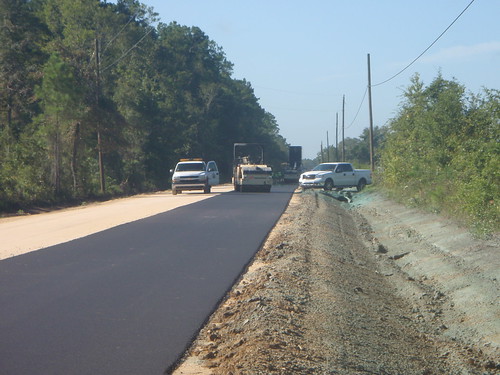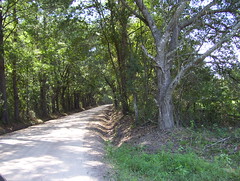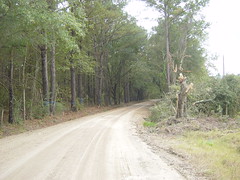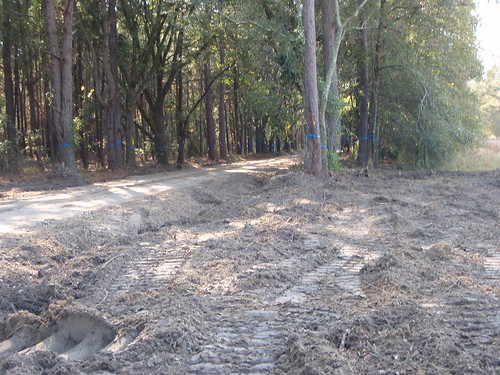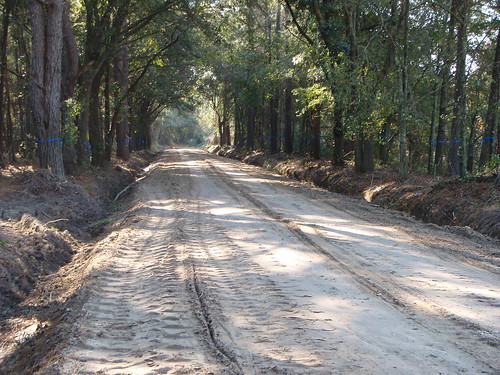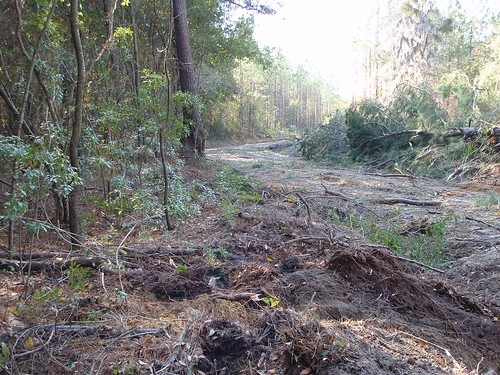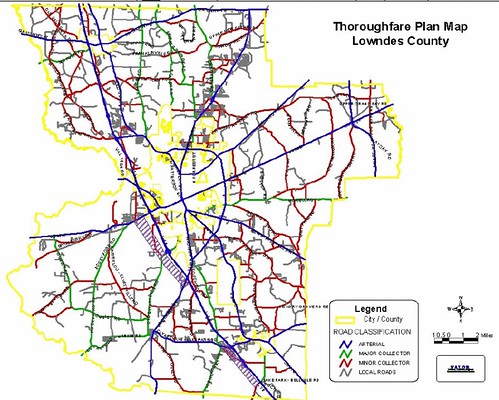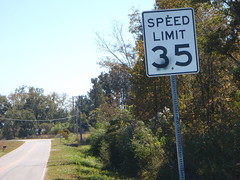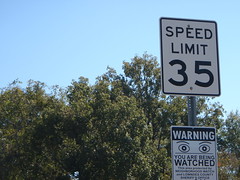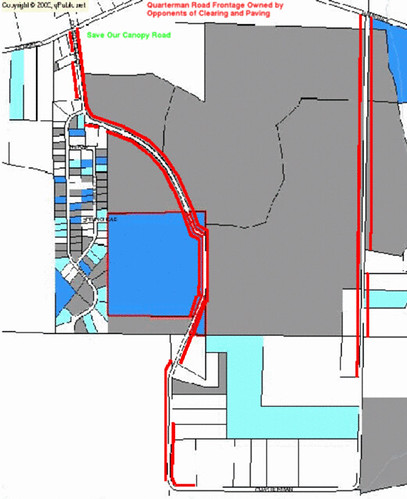Yesterday some of us finally got to talk to one of the paving proponents inside the county government to try to persuade him to
Save Our Canopy Road In response we hear Safety! Professional engineer’s opinion! AASHTO standards! Highest and best use!
Why the county should determine highest and best use is different from what 60% of the
households on the road have said in a petition is mysterious to me; more on that below.
They claim they have to have a 60 foot right of way, that they can’t have trees close to the roadbed, they have to have wide sloping ditches, paving just like Hambrick Road, and a 45 MPH speed limit.
 Yet just across the state line, Leon County, Florida advertises their canopy roads
as tourist attractions, and both dirt and paved they have trees
just as close to the roadbed as our canopy does now. Pictured on the right is
Old Bainbridge Road, Leon Co., Fla. Does it remind you of anything?
Yet just across the state line, Leon County, Florida advertises their canopy roads
as tourist attractions, and both dirt and paved they have trees
just as close to the roadbed as our canopy does now. Pictured on the right is
Old Bainbridge Road, Leon Co., Fla. Does it remind you of anything?
Tallahassee is well known for its canopy roads. Valued by citizens, the roads offer a peaceful alternative to the typical city view of asphalt, cement, signs and visual clutter.
They have canopy road regulations in the county code,
plus a tree inventory, a management schedule, an interactive tour, and
a printable 11 page brochure.
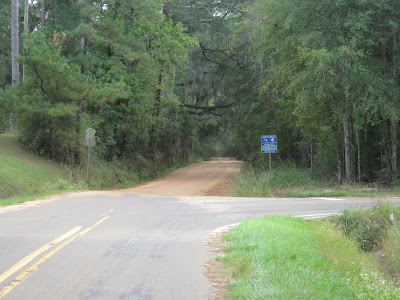 Some of their canopy roads are dirt, such as
old Magnolia Road (middle of page 6):
Some of their canopy roads are dirt, such as
old Magnolia Road (middle of page 6):
“…one of our most scenic dirt roads. Because of slow driving along
Magnolia Road, this detour will add about 40 minutes. Magnolia Road
can be slick in rainy weather.”
“Historic Magnolia Road is one of the most Picturesque in Leon County.
…Remember to wave at those you pass — it’s southern tradition on
dirt roads.”
Others were paved carefully to protect the canopy:
“Drive slowly and enjoy the majesty of this beautiful road with its lush
vegetation. This first portion of Miccosukee Road was paved in the 1980s.
Care was taken to preserve the rural character of the road; it is narrow
and weaves to protect the canopy.”
Leon County is far from alone in Florida in having canopy roads.
Sarasota County has
61 canopy roads, and a “Canopy Road Ordinance (Art. IV, §98-92)”.
Here are
pictures of canopy roads all over Florida.
Some are dirt, some are paved. Most have trees just as close to the
roadbed as on Quarterman Road.
And Florida is far from alone. Here’s one
near Buffalo, NY.
Here’s a writeup by the town of Mount Pleasant on
Mathis Ferry Road, Mount Pleasant, SC,
citing a state scenic roads program. Georgia has one of those, too.
What about Savannah? Surely everyone has driven along
Victory Drive.
Or
US 17 near Eulonia in McIntosh Co. on the way to Darien.
If all that is not enough to address the safety issue,
here’s a canopy road that GDOT admits is 20% safer than other roads of its class:
Forest Hill Road, Bibb County, Georgia.
AASHTO standards are guidelines, not requirements. Obviously other places
have managed not only to keep canopy roads with safety, they have
turned them into tourist assets.
That seems like a higher and better use than tearing them down.
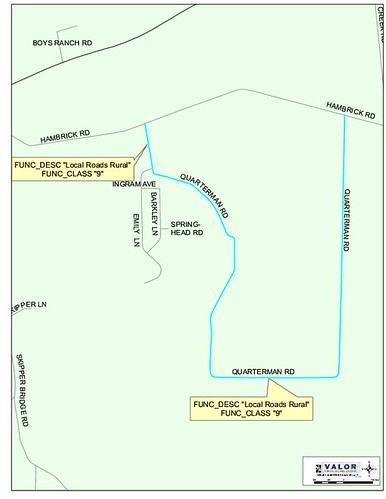 Previously we were also told by the county
that Quarterman Road had been redesignated by the state as
a collector. I checked Thursday, and GDOT says Quarterman Road, Lowndes County Road 160,
is functional class 9, rural local road.
GDOT tells me that this means the state does not tell the county what to do with this road: the state does not
require a 60 foot right of way, and the county could improve
or pave the road in any number of other ways.
If the county took state money, the state might make requirements,
but SPLOST VI is not state money: it’s a local tax.
Previously we were also told by the county
that Quarterman Road had been redesignated by the state as
a collector. I checked Thursday, and GDOT says Quarterman Road, Lowndes County Road 160,
is functional class 9, rural local road.
GDOT tells me that this means the state does not tell the county what to do with this road: the state does not
require a 60 foot right of way, and the county could improve
or pave the road in any number of other ways.
If the county took state money, the state might make requirements,
but SPLOST VI is not state money: it’s a local tax.
There are paved roads in Lowndes County right now that are not 60 feet wide, such as Rusk Road, and if I’m not mistaken Chapelle Road.
It’s clear that Quarterman Road does not have to have a 60 foot right of way cleared,
even if it is paved.
Lowndes County government proponents of paving have not responded
to requests for other options. We asked when they attended a neighborhood
meeting on June 5. I asked in a letter of August 7. Others called and asked.
Nobody ever responded. The way we discovered the county was moving ahead
with paving was when I saw a truck creeping along and asked what they
were doing:
Looking to see what it will take to tear down all the trees along the right of way!
It’s going up for bids Monday!
Since then the county has put the road out for bids and they
selected the low bid Monday Nov 3rd.
Unless the commission stops it Tuesday Nov 11th, clearing starts Wednesday Nov 12th.
We finally got a meeting with our county commissioner Friday Nov 7th (yesterday).
How does Leon County do it?
They treat it as a community planning project.
They have a canopy roads committee with four members from the county
and four members from the city that recommends roads to designate as
canopy roads.
They have workshops on:
“how to manage, protect and plan for the future
of the canopy roads and canopy corridors in Tallahassee, Leon County.”
We can only assume that Lowndes County is unaware of these many examples of canopy roads in other counties.
I’m sure there are people on Quarterman Road who would be happy to find out
more about how other counties do it.
The first thing to be done is to stop the clearing of Quarterman Road,
and we ask the county commission to stop that Tuesday.
We also ask the county to establish a citizens’ committee to
evaluate canopy roads in the county and how to preserve them.
How many county roads are there in the county?
How are they being protected?
What guidelines can we develop to preserve them?
How do other counties maintain their canopies with safety for residents?
This is a planning and zoning issue, not just an engineering issue.
It is also a citizens’ issue, not just a county government issue.
The Lowndes County Commission meeting of Tuesday 11 November is public.
The county government likes citizen participation.
Help us preserve the rural character of our canopy road, and of Lowndes County.
Y’all come!
